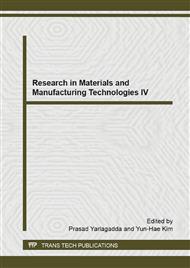p.431
p.436
p.441
p.446
p.450
p.454
p.460
p.465
p.471
Effect of Chamfer Angle on the Stress Distribution in Weld-Boded Single Lap Aluminum Joint
Abstract:
The effect of the outer chamfered angle at the free end of adherend on the stress distribution in weld-bonded single lap aluminum joint was investigated using elasto-plastic finite element method (FEM). The results from the numerical simulation showed that the peak stress along the bondline at the end of lap zone decreases when the adherend is chamfered on the outside and it is decreased greatly as the chamfer angle decreased. Compared to the results from the normal joint, a 15 degree chamfer angle may be appropriate to optimize the stress distribution in the weld-bonded single lap aluminum joint.
Info:
Periodical:
Pages:
450-453
Citation:
Online since:
December 2014
Authors:
Keywords:
Price:
Сopyright:
© 2015 Trans Tech Publications Ltd. All Rights Reserved
Share:
Citation:


